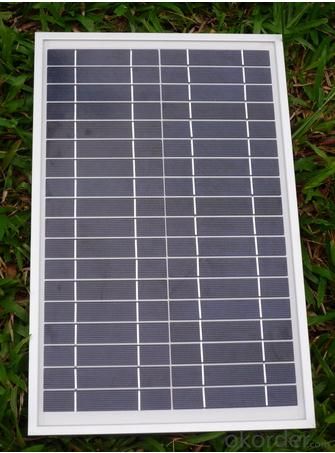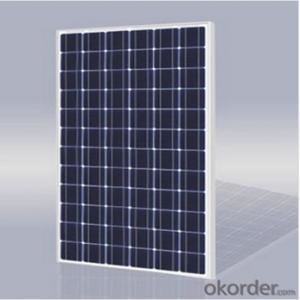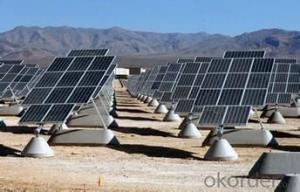130KW CNBM Monocrystalline Silicon Panel for Home Using
- Loading Port:
- Tianjin
- Payment Terms:
- TT OR LC
- Min Order Qty:
- 50 watt
- Supply Capability:
- 1000 watt/month
OKorder Service Pledge
OKorder Financial Service
You Might Also Like
Item specifice
130KW CNBM Monocrystalline Silicon Panel for Home Using
Production description
Off-the-grid homes are autonomous; they do not rely on municipal water supply, sewer, natural gas, electrical power grid, or similar utility house in the high-desert wilderness of Northern Arizona, collecting rainwater, composting waste, and paying nothing for utilities.[4][5]
The large magnitude of solar energy available makes it a highly appealing source of electricity. The United Nations Development Programme in its 2000 World Energy Assessment found that the annual potential of solar energy was 1,575–49,387 exajoules (EJ). This is several times larger than the total world energy consumption, which was 559.8 EJ in 2012.
Electrical power can be generated on-site with renewable energy sources such as solar (particularly with photovoltaics), wind, micro hydro, geothermal; with agenerator or Micro combined heat and power with adequate fuel reserves. Such a system is called a stand-alone power system. In addition, it is possible to simply eliminate electric power such as in Old Order Amish and Old Order Mennonite communities.
Feature
1.High conversion efficiencies resulting in superior power output performance.
2.Outstanding power output even in low light or high temperature conditions
3.Optimized design for ease of soldering and lamination
Physical characteristic
1. Rigorous quality control meets the highest international standards.
2. High-transmissivity low-iron tempered glass, strong aluminium frame.
3. Using UV-resistant silicon.
4. IS09001/14001/CE/TUV/UL
Packaging
26pcs in one carton 6pallets in 20foot container 14pallets in 40 foot container.
- Q:Can solar energy systems be used in areas with limited access to educational resources?
- Yes, solar energy systems can be used in areas with limited access to educational resources. Solar energy systems are relatively simple to install and operate, requiring minimal technical knowledge. With basic training and guidance, local communities can learn to set up and maintain solar systems, even in areas with limited educational resources. Additionally, there are numerous online resources and organizations that provide educational materials and support for individuals and communities interested in harnessing solar energy. Thus, solar energy systems can be a viable and sustainable solution for areas with limited access to educational resources.
- Q:Can solar energy systems be used for charging electric vehicles?
- Yes, solar energy systems can be used for charging electric vehicles. Solar panels can be installed on rooftops or in open spaces to harness sunlight and convert it into electricity. This electricity can then be used to charge electric vehicle batteries, providing a sustainable and renewable source of energy. Additionally, with advancements in technology, solar-powered charging stations are being developed to further facilitate the use of solar energy for electric vehicle charging.
- Q:How do solar energy systems impact water quality?
- Solar energy systems have a minimal impact on water quality. Unlike fossil fuel-based power generation, solar energy does not produce any harmful pollutants or emissions that can contaminate water sources. This makes solar energy systems a cleaner and more sustainable alternative, ensuring that water quality remains unaffected by their operation.
- Q:Are there any risks of electrical shocks during installation or maintenance of solar energy systems?
- Yes, there are risks of electrical shocks during the installation or maintenance of solar energy systems. These risks can occur due to the high voltage of the system, improper grounding, faulty wiring, or inadequate safety precautions. It is crucial to follow proper safety procedures, use appropriate personal protective equipment, and ensure that qualified professionals handle the installation and maintenance to minimize the risk of electrical shocks.
- Q:Can solar energy systems be used for heating swimming pools?
- Yes, solar energy systems can be used for heating swimming pools. Solar thermal systems are specifically designed to collect and harness the sun's heat, which can then be used to warm water in swimming pools. These systems are cost-effective, environmentally friendly, and can significantly reduce energy consumption compared to traditional heating methods.
- Q:Can solar energy systems be used in areas with limited access to social services?
- Yes, solar energy systems can be used in areas with limited access to social services. Solar energy systems are a decentralized and standalone source of electricity, which means they can be installed and operated independently. This makes them suitable for remote or underdeveloped areas where access to social services, including reliable electricity, may be limited. Solar energy systems can provide a sustainable and affordable solution for generating electricity, powering essential services such as lighting, water pumps, and communication devices, thereby improving the quality of life in these areas.
- Q:Can solar energy systems be used in all regions?
- Solar energy systems can be used in all regions to some extent. However, the efficiency and effectiveness of solar energy systems may vary depending on factors such as the amount of sunlight available, local climate conditions, and geographical location. Regions with abundant sunlight and favorable weather conditions tend to be more suitable for harnessing solar energy efficiently. Nonetheless, advancements in solar technology and the availability of storage solutions are continuously improving the viability of solar energy systems in a wider range of regions.
- Q:How does a PV system convert sunlight into electricity?
- A PV system, also known as a solar panel system, converts sunlight into electricity through the use of photovoltaic cells. These cells are made of semiconducting materials, typically silicon, which have the ability to convert sunlight directly into electricity. When sunlight hits the surface of the PV cells, it excites the electrons within the material, causing them to flow, creating an electric current. This current is then captured and harnessed by the system, allowing it to be used as electricity for various purposes.
- Q:Are there any regulations or permits required for installing solar energy systems?
- Yes, there are regulations and permits required for installing solar energy systems. The specific requirements vary depending on the location and jurisdiction, as regulations are set at the local, state, and national levels. These regulations and permits are put in place to ensure that the installation of solar energy systems is safe, compliant with building codes, and meets local zoning requirements. Typically, a building permit is required to install a solar energy system. This permit ensures that the installation is done correctly and follows all necessary safety guidelines. The permit process usually involves submitting detailed plans and documentation, including structural engineering reports and electrical diagrams. These documents are reviewed by the local building department to ensure compliance with applicable codes and regulations. In addition to building permits, there may be other permits or approvals required for solar energy systems. This could include electrical permits, zoning permits, or even historic preservation approvals in certain areas. It is important to consult with the relevant authorities and obtain all necessary permits before installing a solar energy system to avoid any legal or safety issues. Furthermore, some jurisdictions may have specific regulations regarding the size, placement, and design of solar energy systems. These regulations are typically aimed at preserving the aesthetics of the area and ensuring the systems do not pose any risks or nuisances to neighboring properties. It is worth noting that regulations and permit requirements are constantly evolving and can vary greatly from one jurisdiction to another. Therefore, it is advisable to consult with local authorities or hire a professional solar energy installer who is familiar with the local regulations to ensure compliance throughout the installation process.
- Q:Can solar energy systems be used in powering dental clinics or medical clinics?
- Yes, solar energy systems can be used to power dental clinics or medical clinics. Solar panels can be installed on the roofs of these facilities to capture sunlight and convert it into electricity, which can be used to meet their energy needs. This not only helps to reduce their reliance on fossil fuels but also provides a clean and sustainable source of power. Additionally, solar energy systems can be designed to store excess energy for use during non-sunlight hours, ensuring a continuous power supply for critical medical equipment and operations.
1. Manufacturer Overview |
|
|---|---|
| Location | |
| Year Established | |
| Annual Output Value | |
| Main Markets | |
| Company Certifications | |
2. Manufacturer Certificates |
|
|---|---|
| a) Certification Name | |
| Range | |
| Reference | |
| Validity Period | |
3. Manufacturer Capability |
|
|---|---|
| a)Trade Capacity | |
| Nearest Port | |
| Export Percentage | |
| No.of Employees in Trade Department | |
| Language Spoken: | |
| b)Factory Information | |
| Factory Size: | |
| No. of Production Lines | |
| Contract Manufacturing | |
| Product Price Range | |
Send your message to us
130KW CNBM Monocrystalline Silicon Panel for Home Using
- Loading Port:
- Tianjin
- Payment Terms:
- TT OR LC
- Min Order Qty:
- 50 watt
- Supply Capability:
- 1000 watt/month
OKorder Service Pledge
OKorder Financial Service
Similar products
New products
Hot products
Related keywords




























